The NISAR Mission: Studying our planet like never before
Tech Toys Hacks: The NASA-ISRO Synthetic Aperture Radar (NISAR) mission is a
landmark collaboration between NASA and the Indian Space Research Organization
(ISRO) that will revolutionize our understanding of the Earth and its natural
systems. This cutting-edge mission aims to provide new insights into the
processes that contribute to changes in our planet's ecosystems, ice masses,
and natural systems, and it has the potential to greatly enhance our ability to
respond to natural disasters and other global challenges.
One of the key features of the NISAR mission is its use of a
synthetic aperture radar (SAR) instrument. SAR is a type of remote sensing
technology that uses radar to produce images of the Earth's surface. Unlike
traditional optical remote sensing technologies, SAR is able to penetrate
through clouds and observe the Earth's surface even in the presence of heavy
rain or snow. This makes it an incredibly valuable tool for studying our
planet, especially in areas that are frequently obscured by clouds.
The NISAR mission is unique in that it will be the first
satellite mission to use dual frequency (L-band and S-band) radar observations.
This will allow for the creation of high-resolution, detailed images of the
Earth's surface, which will provide a wealth of new information about the
planet. The NISAR mission will be able to observe a wide range of phenomena,
including earthquakes, volcanic eruptions, and changes in ice cover, as well as
track changes in land use and land cover over time.
One of the key benefits of the NISAR mission is its ability
to improve our understanding of the causes of and response to natural
disasters. For example, the mission will provide new insights into the dynamics
of earthquakes, which will help scientists better understand the underlying
processes and develop new strategies for predicting and mitigating the impacts
of these events. The NISAR mission will also be able to observe the impact of
natural disasters, such as floods, landslides, and wildfires, on the Earth's
surface and help decision-makers respond more effectively to these events.
Another important benefit of the NISAR mission is its
ability to increase our knowledge about the role of polar ice in sea level
rise. The mission will be able to observe changes in the polar ice caps, which
will help scientists better understand the relationship between ice loss and
sea level rise, and develop more accurate projections of future sea level
change.
Finally, the NISAR mission will greatly enhance our ability
to monitor agriculture and forest ecosystems. The high-resolution images
produced by the mission will provide detailed information about the health and
productivity of these ecosystems, which will be invaluable for agriculture and
forest management.
In conclusion, the NISAR mission is a groundbreaking
collaboration between NASA and ISRO that will greatly enhance our understanding
of the Earth and its natural systems. With its ability to produce
high-resolution images of the Earth's surface, the NISAR mission has the
potential to provide new insights into a wide range of phenomena and greatly
improve our ability to respond to natural disasters and other global
challenges. The NISAR mission is scheduled for launch in early 2023, and we
can't wait to see the groundbreaking results it will produce.
.jpeg)
.jpeg)





Comments
Post a Comment
If you any doubts, please let me know.